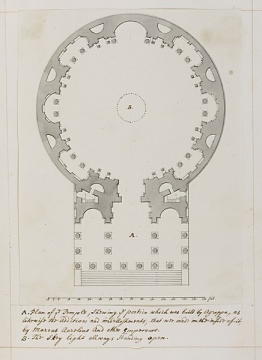Scale
1 inch to about 37 feet (drawn scale; same as for 1)
Inscribed
By Gibbs in pen and brown ink over pencil, on plan, A. and B., and below plan at foot of p. 13, A. Plan of ye Temple, shewing ye portico which was built by Agrippa, as likewise the addtions and imbellishments, that wer made in the inside of it, by Marcus Aurelius and other Emperours. / B. The Skey light allways standing open.
Signed and dated
Medium and dimensions
Pen and grey ink with grey wash over pencil, and with brown ink for letters and dotted plan of aperture; on laid paper; 197 x 149.
Hand
James Gibbs
Watermark
none visible
Notes
The plan is taken from Fontana's on p. 465 of Il Tempio Vaticano, but the internal circuit of steps is omitted. Gibbs has also modified the reveals of the door and has added recesses within reveals of the internal wall, beyond the door. He has also eliminated to small external flights of steps which connected the internal triangular flights behind the portico walls with the adjacent wall of the rotunda. Another feature that he removed from Fontana's plan, section and elevation of the Pantheon in Imperial times was an external podium beneath the side columns of the portico, which Fontana shows in plan as a narrow wall projecting beyond the line of the column bases on each side.
Level
Drawing
Digitisation of the Drawings Collection has been made possible through the generosity of the Leon Levy Foundation
Sir John Soane's collection includes some 30,000 architectural,
design and topographical drawings which is a very important resource for
scholars worldwide. His was the first architect’s collection to attempt to
preserve the best in design for the architectural profession in the future, and
it did so by assembling as exemplars surviving drawings by great Renaissance
masters and by the leading architects in Britain in the 17th and 18th centuries
and his near contemporaries such as Sir William Chambers, Robert Adam and
George Dance the Younger. These drawings sit side by side with 9,000 drawings
in Soane’s own hand or those of the pupils in his office, covering his early
work as a student, his time in Italy and the drawings produced in the course of
his architectural practice from 1780 until the 1830s.
Browse (via the vertical menu to the left) and search results for Drawings include a mixture of
Concise catalogue records – drawn from an outline list of the collection – and
fuller records where drawings have been catalogued in more detail (an ongoing
process).


